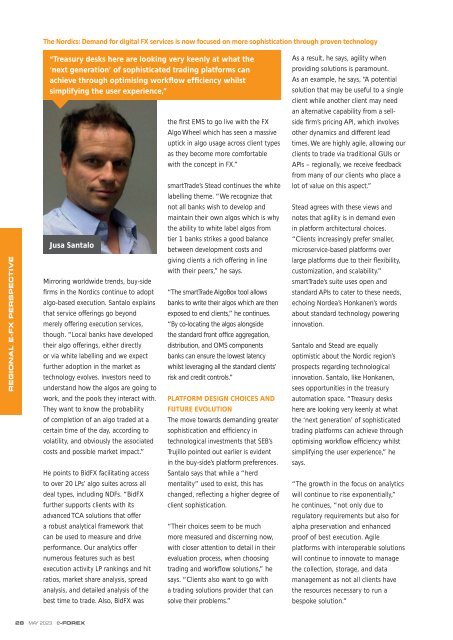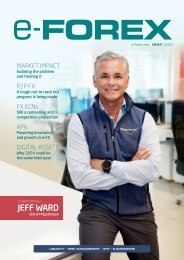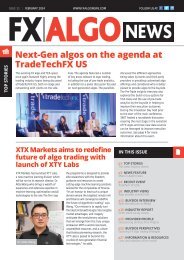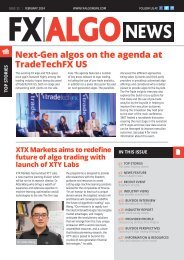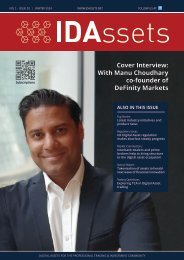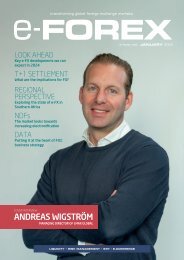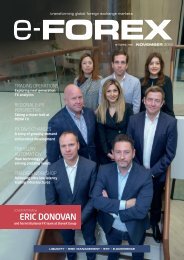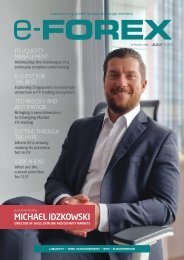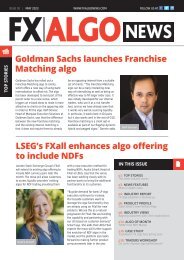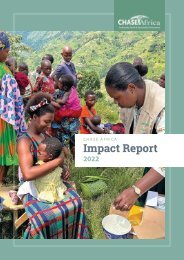Create successful ePaper yourself
Turn your PDF publications into a flip-book with our unique Google optimized e-Paper software.
The Nordics: Demand for digital FX services is now focused on more sophistication through proven technology<br />
REGIONAL E-FX PERSPECTIVE<br />
“Treasury desks here are looking very keenly at what the<br />
‘next generation’ of sophisticated trading platforms can<br />
achieve through optimising workflow efficiency whilst<br />
simplifying the user experience,”<br />
Jusa Santalo<br />
Mirroring worldwide trends, buy-side<br />
firms in the Nordics continue to adopt<br />
algo-based execution. Santalo explains<br />
that service offerings go beyond<br />
merely offering execution services,<br />
though. “Local banks have developed<br />
their algo offerings, either directly<br />
or via white labelling and we expect<br />
further adoption in the market as<br />
technology evolves. Investors need to<br />
understand how the algos are going to<br />
work, and the pools they interact with.<br />
They want to know the probability<br />
of completion of an algo traded at a<br />
certain time of the day, according to<br />
volatility, and obviously the associated<br />
costs and possible market impact.”<br />
He points to BidFX facilitating access<br />
to over 20 LPs’ algo suites across all<br />
deal types, including NDFs. “BidFX<br />
further supports clients with its<br />
advanced TCA solutions that offer<br />
a robust analytical framework that<br />
can be used to measure and drive<br />
performance. Our analytics offer<br />
numerous features such as best<br />
execution activity LP rankings and hit<br />
ratios, market share analysis, spread<br />
analysis, and detailed analysis of the<br />
best time to trade. Also, BidFX was<br />
the first EMS to go live with the FX<br />
Algo Wheel which has seen a massive<br />
uptick in algo usage across client types<br />
as they become more comfortable<br />
with the concept in FX.”<br />
smartTrade’s Stead continues the white<br />
labelling theme. “We recognize that<br />
not all banks wish to develop and<br />
maintain their own algos which is why<br />
the ability to white label algos from<br />
tier 1 banks strikes a good balance<br />
between development costs and<br />
giving clients a rich offering in line<br />
with their peers,” he says.<br />
“The smartTrade AlgoBox tool allows<br />
banks to write their algos which are then<br />
exposed to end clients,” he continues.<br />
“By co-locating the algos alongside<br />
the standard front office aggregation,<br />
distribution, and OMS components<br />
banks can ensure the lowest latency<br />
whilst leveraging all the standard clients’<br />
risk and credit controls.”<br />
PLATFORM DESIGN CHOICES AND<br />
FUTURE EVOLUTION<br />
The move towards demanding greater<br />
sophistication and efficiency in<br />
technological investments that SEB’s<br />
Trujillo pointed out earlier is evident<br />
in the buy-side’s platform preferences.<br />
Santalo says that while a “herd<br />
mentality” used to exist, this has<br />
changed, reflecting a higher degree of<br />
client sophistication.<br />
“Their choices seem to be much<br />
more measured and discerning now,<br />
with closer attention to detail in their<br />
evaluation process, when choosing<br />
trading and workflow solutions,” he<br />
says. “Clients also want to go with<br />
a trading solutions provider that can<br />
solve their problems.”<br />
As a result, he says, agility when<br />
providing solutions is paramount.<br />
As an example, he says, “A potential<br />
solution that may be useful to a single<br />
client while another client may need<br />
an alternative capability from a sellside<br />
firm’s pricing API, which involves<br />
other dynamics and different lead<br />
times. We are highly agile, allowing our<br />
clients to trade via traditional GUIs or<br />
APIs – regionally, we receive feedback<br />
from many of our clients who place a<br />
lot of value on this aspect.”<br />
Stead agrees with these views and<br />
notes that agility is in demand even<br />
in platform architectural choices.<br />
“Clients increasingly prefer smaller,<br />
microservice-based platforms over<br />
large platforms due to their flexibility,<br />
customization, and scalability.”<br />
smartTrade’s suite uses open and<br />
standard APIs to cater to these needs,<br />
echoing Nordea’s Honkanen’s words<br />
about standard technology powering<br />
innovation.<br />
Santalo and Stead are equally<br />
optimistic about the Nordic region’s<br />
prospects regarding technological<br />
innovation. Santalo, like Honkanen,<br />
sees opportunities in the treasury<br />
automation space. “Treasury desks<br />
here are looking very keenly at what<br />
the ‘next generation’ of sophisticated<br />
trading platforms can achieve through<br />
optimising workflow efficiency whilst<br />
simplifying the user experience,” he<br />
says.<br />
“The growth in the focus on analytics<br />
will continue to rise exponentially,”<br />
he continues, “not only due to<br />
regulatory requirements but also for<br />
alpha preservation and enhanced<br />
proof of best execution. Agile<br />
platforms with interoperable solutions<br />
will continue to innovate to manage<br />
the collection, storage, and data<br />
management as not all clients have<br />
the resources necessary to run a<br />
bespoke solution.”<br />
28 MAY 20<strong>23</strong> e-FOREX


